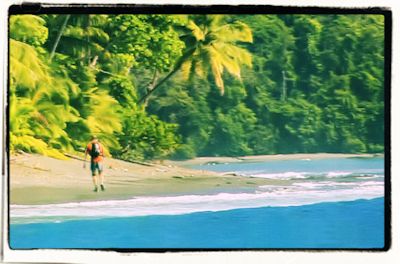
Hiking in Costa Rica
Trails, towns, national parks, beaches, and forests offer a wide range of possibilities for beginners and experienced travelers.
Costa Rica has enough trails to keep serious hikers stepping for a long time, and the scenery those routes pass ranges from lowland rain forests to brisk mountain valleys. The routes themselves are as varied as the scenery, ranging from invigorating jaunts in the mountains near San Jose to backpacking adventures that lead you into the heart of the country’s wilderness.
Nearly all of Costa Rica’s national parks have short trails that can be hiked in an hour or two, while others have routes that take the better part of a day to complete, such as the trails to the top of Barva and Rincon de le Vieja Volcanoes. Santa Rosa, Corcovado and Chirripo National Parks have longer backpacking routes, which require several overnights in tents or Parks Service cabins. There are also plenty of well marked hiking trails in the country’s growing number of private reserves.
Footprints in the sand
Atlantic Coast. In Cahuita National Park, in the Limon province, with over 130 miles of sand, you can walk along Playa Blanca and Puerto Vargas, next to Playa Negra. The park stands out for its coral reefs and tropical jungle topped off with coconut palm trees.
The Pacific. Along the 125 miles of beach in the Guancaste province, there are options for all tastes at beaches like Naranjo, Hermosa, el Coco, Avellana, Junquillal, and Manzanillo. The majority are whitesand beaches with crystal-clear water and lush vegetation. There are also opportunities for swimming, diving, surfing, and fishing. In some places you can even find sea turtle nesting areas.
The Southern Pacific. This region that encompasses the Osa Peninsula had been referred to as «one of the most intense biological sites in the world,» according to National Geographic. Corcovado National Park and Cano Island Biological Reserve have miles of beaches that are challenging for even the most experienced hikers.

The Central Valley
The cultural center. For those who enjoy art, over the last few years the capital has unveiled new attractions. These include the Pope John Paul II sculpture just north of the Metropolitana Cathedral; the «Barrendero»sculpture in the Central Park, and «la Chola» sculpture just south of the Costa Rican Central Bank.
The dry months, from November to March, are ideal for planning excursions throughout the city and enjoying the warm afternoon sun. Starting at the central part of San José, going west to east, you can see the main structures of downtown like the Metropolitana Cathedral, the National Theater, the National Museum, the Legislative Assembly, and the Blue Castle (Castillo Azul).
Continuing toward the east, you can find other points of interest to visit such as the Museum of Art and Contemporary Design, the Yellow House (Casa Amarilla), the Metallic Building (Edificio Metálico), the Jade Museum, and Morazán Park, among others.
Natural attractions
The hills of Escazu have great natural and scenic beauty, with a view of Blanco Peak, San Miguel hill, and a panoramic view of the Central Valley. There is a 5-6 mile long hiking trail there that takes around 5-6 hours to hike.
The Cerro Dantas Wildlife Refuge in Heredia, some 13 miles northeast of the National University, offers forest paths measuring some 6 miles that take about 5 hours.
Los Santos zone is known for its highland forest and pastures that extend to Providencia, a town along the Savegre River. From there, you can pass through a primary forest until you reach San Gerardo de Dota. This 15-mile stretch takes about 9-10 hours to hike.

Let’s go hiking!
Comentarios Facebook